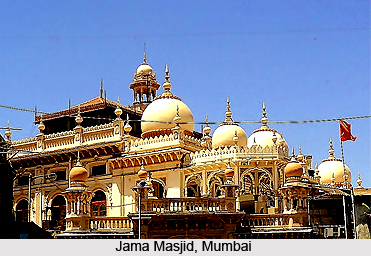 Jama Masjid is a prominent mosque of Mumbai, situated in the Kalbadevi neighbourhood. It is the most ancient and largest mosque of the city. The chronogram, Jahas-i-Akhirat, states that the mosque was completed in 1802 AD. It also suggests that it was built on a tank. The tank in the 18th century was set amidst open land and gardens and was owned by a Konkani Muslim merchant who used to trade in Goa and Calicut. In the year 1778 the merchant agreed for the construction of the mosque provided the tank remains preserved intact. The initial nucleus of the present mosque was thus erected then which comprised of a one storey building.
Jama Masjid is a prominent mosque of Mumbai, situated in the Kalbadevi neighbourhood. It is the most ancient and largest mosque of the city. The chronogram, Jahas-i-Akhirat, states that the mosque was completed in 1802 AD. It also suggests that it was built on a tank. The tank in the 18th century was set amidst open land and gardens and was owned by a Konkani Muslim merchant who used to trade in Goa and Calicut. In the year 1778 the merchant agreed for the construction of the mosque provided the tank remains preserved intact. The initial nucleus of the present mosque was thus erected then which comprised of a one storey building.
Architecture of Jama Masjid
The basic architecture of Jama Masjid of Mumbai constitutes a quadrangular pile of stone and brick which is surrounded by a ring of double storeyed and terrace roofed buildings. The ground floors of these buildings have been let out as shops. The eastern gate is the chief gate of the mosque which leads to the ancient tank through an open courtyard. The tank is presently equipped with embankments and masonry steps which were constructed in 1893. It is also filled with stagnant water, up to a height of about 10 feet, with gold and silver fishes.
Sixteen black stone arches which support the whole structure of the mosque rise from the depth of the tank. These were constructed in 1874. Five rows of wooden pillars uphold the upper storey of the mosque and each of the pillars contains a receptacle for sacred books. The construction cost of the arches of tank was quite high. In the year 1898 large windows were built in the east, north and south sides of the mosque. In 1902, a school building was built in the premise.
Other Features of Jama Masjid
In 1897 the high court framed a scheme, according to which the properties and affairs of the mosque are to be managed by a board of eleven directors who were elected by Konkani Muslim Jamat, triennially. The executive functions pertaining to the mosque lies with a Nazir, whom the board appoints. The staffs of the mosque comprises a prayer lead also known as Imam, an assistant imam, a Bangi and an assistant Bangi who summons the devotees for the prayer. Apart from these, several other subordinates also dedicate their services to the mosque. In the school attached to the mosque, known as the Madressa Muhammadiah, free religious and secular education is imparted to Muslim youths. There is also a hostel attached to the school.





















